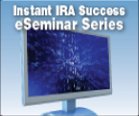It is time for the Thursday Slott Report Mailbag with questions about creditor protection, the difference between the terms "distribution" and "transfer" and the ability of a non-working spouse to contribute to a Roth IRA. As always, we stress the importance of working with a competent, educated financial advisor to keep your retirement nest egg safe and secure. Find out at this link.
1.
My 80-year-old father has a traditional IRA worth considerably under $1 million. If he is sued by creditors, what is the danger to the money while it remains in the IRA? What is the danger to the required minimum distribution? What is the danger to his heirs?
Answer:
The creditor protection afforded IRAs is governed by state law. You will have to check the state law in your state to determine the protection afforded your dad's IRA.
On April 20,2005 President Bush signed the bankruptcy reform bill known as the Bankruptcy Abuse Prevention and Consumer Protection Act of 2005 into law. The provisions under this bill provide greater creditor protection for retirement plan assets, but only in bankruptcy and only if the federal bankruptcy rules are used. They do not apply to judgments awarded in other courts, where state creditor protection laws will apply.
2.
Ed and Company,
My two brothers and I have been equally designated as beneficiaries to a traditional IRA. My mother passed away and we three brothers reviewed the assets in the IRA and determined the distribution of assets by equal value and instructed the custodian to establish three inherited/beneficiary IRAs. We clearly specified each asset to each account and all three of us signed each other's letter of authorization to prove full agreement and value calculations down to the penny. These letters of authorization (LOA) were produced by the custodian.
Now we are being told by the custodian that the LOAs are on hold because "Per our Estate Services Office the IRC code is: IRC 408 d 3 c." I have read and studied this reference which talks about denial of a rollover contribution to an inherited IRA, which does not apply to the distribution of IRA assets for the creation of new individual inherited IRAs. Also the custodian stated that the IRS requires assets not divisible by three have to be sold and cash distributed. I called the IRS and registered a ticket and had a wonderful discussion with an IRS agent that made it perfectly clear to me that the holdings/assets in the IRA are of no concern to the IRS. The IRS is concerned about the values going and values coming out for tax purposes. Hence I feel we are being poorly served by the custodian who I feel is acting in conflict of interest to collect fees on asset sales and re-purchases in the IRA.
Are we wrong in demanding the custodian honor our initial LOAs?
Tim Pearson
Answer:
Interesting dilemma. I wonder if there is a confusion here in using the term "distribution" versus "transfer". The regulations clearly state that a non-spouse beneficiary can do a transfer (you do not have the ability to spend the funds) but not a distribution (you do have the ability to spend the funds while they are out of the IRA) of inherited assets. The other factor here is the custodian’s policy. Perhaps they will only divide individual assets into thirds (this is NOT an IRS rule). Or perhaps they do not allow a transfer even though the law allows it. If the custodian would allow a trustee to trustee transfer, directly from one institution to another, you could consider moving the entire amount to a new custodian that will allow the transfer of assets among the beneficiaries in the manner you wish and have the new custodian do the split.
3.
Can the spouse of a self-employed earner contribute to a Roth? I'm not clear in tax info I've read. Please advise.
Answer:
A non-working spouse can contribute to a Roth IRA so long as the working spouse has enough earned income. There are, however, phase-out limits for contributions to Roth IRAs. If you are filing a joint tax return the phase-out starts at $169,000 and completely phases-out at $179,000. If you are filing married-separate your phase-out range is $0 to $10,000.
The Roth contribution can be made up to the tax filing date, which this year was April 18, 2011. There is no extension beyond that date, regardless of whether an extension is filed for the income tax return. The contribution limit for 2011 is $5,000. However, if you are age 50 or older by 12/31/2011 you can add a catch up contribution of up to $1,000 for a total of $6,000.
By Marvin Rotenberg and Jared Trexler
------------------------------------------------------------------------------
Comment, Question, Discussion Topic on your mind? Click on the Blue Comment Link below and leave your thoughts then check back to see what other consumers and advisors think.
*Copyright 2011 Ed Slott and Company, LLC
Subscribe to:
Post Comments (Atom)





0 comments:
Post a Comment